BEYOND BASED AND CRINGE
Posted by <Nate Sloan> on 2021-06-21
IT IS ONLY THROUGH A RECOGNITION OF THE FAILURES OF PREVIOUS MODES OF SINCERITY IN ART THAT THESE SAME CULTURAL ARTIFACTS MAY BE REDEEMED
We are in an era of hyperreferentiality in cultural production. Images/artworks/aesthetics from myriad different historical periods function interchangeably in a sea of reference facilitated by online networks. The sort of ironic disposition of the late ‘00’s - early ‘10s hipster is now passé. The notion of enjoying something “ironically” has now become so diffused within our culture, ironic enjoyment is nearly indistinguishable from sincere appreciation. (Footnote 1) This blurring of the boundary between irony and sincerity in culture is everywhere observable today, from “irony-poisoned” social media users drifting towards political reaction, to the remix of Rebecca Black’s Friday.
It may seem that the flattening of culture via the internet’s penchant for hyperreferentiality necessarily leads to a kind of total ironic detachment or relativism, in which any aesthetic/ideology/image is interchangeable, with its only value located in the ability to shock the viewer or to direct them to other images/symbols/signs.
Indeed, there are many corners of the internet, perhaps most notably 4chan’s /pol/ board, in which the value of a given post (text, image, or most often some combination of the two) seems only to be its ability to shock. As you might imagine, this leads to the creation of an incredibly toxic environment, in which detestable views compete for eyeballs and clicks. Do these anons really believe what they are posting? This question is ultimately unanswerable. Near infinite layers of ironic distancing create an environment where a user may slide into a belief that was once nothing more than a joke. This phenomenon is termed “irony poisoning.” (Footnote 2)
Yet the embrace in popular media of “The New Sincerity,” (Footnote 3) observable in sitcoms such as The Office (US), and Parks and Recreation, leaves a bitter taste in the mouths of viewers who aptly recognize the hollow nature of these portrayals of workplace community. This movement towards sincerity in literature, most notably associated with David Foster Wallace, presented a valid critique of the everpresent irony of its day (1990s). However, its failure to escape the dominant mode of Capitalist Realism is evidenced by its deployment in service of network television programs, whose primary function is advertising. (Footnote 4) While it is nice to be nice, it should go without saying that these depictions nevertheless serve the financial interests of the major networks that broadcast them.
This deployment of sincerity in mainstream media supports the larger functioning of the Professional-Managerial Class (PMC), identified by Barbara and John Ehrenreich in 1977 in their seminal essay The New Left and the Professional-Managerial Class. (Footnote 5) The mode of capitalism in the neoliberal era, rather than force, instead makes use of the PMC to produce the cultural conditions that enable capitalism’s reproduction. Those in the media, academia, and other culture industries reinforce capitalism’s ubiquity and the lack of alternative visions of the future via their cultural output (T I N A). This propagandistic effect is easily observed in The Office (US). While your boss might be an obnoxious bore, and you may be exploited and alienated from your labor in the workplace, sincere friendship and romance ultimately win out, thus redeeming the exploitation of today’s society. This indifference to real social change plays perfectly into the hands of capital.
BASED AND CRINGE
At this point, it will serve to define some terms that, in internet parlance, relate to notions of irony and sincerity; specifically, the dichotomy of “based” and “cringe”.
“Based” in its current usage, stems from the rapper Lil B, who used the term to indicate a kind of nearly ineffable authenticity and ease with oneself. (Footnote 6) In the years following his injection of the term into the online sphere, it came to be a favorite of the reactionary posters on 4chan and elsewhere. Their use of the term frequently characterized persons and ideological movements that were reactionary or openly fascistic. They contrast “based” with “cringe.” While technically an abbreviation of “cringeworthy,” the specialized usage of the term in these environments tended to describe an overly-sincere naïvete or lack of familiarity with the protocols and language of the terminally online. Given the irony-poisoning of many of these spaces, the “cringe” label is also widely applied to sincerity, writ large. This toxic relativism, leading in some cases to full on political reaction, may also be considered in relation to the larger trends of postmodernism in culture, which broadly may be categorized as a rejection of the high-minded ideals and absolutes that characterized modernism before it.
How then to move forward, for those of us who recognize and rightfully disdain the cringeworthy sincerity of a sitcom like The Office (US), whose primary function is to inoculate a public to the unvarnished misery of late capitalism, but reject the notion that all forms of sincerity/belief/faith are inherently flawed or doomed to come to nothing?
WHAT DOES IT MEAN TO MOVE BEYOND BASED AND CRINGE?
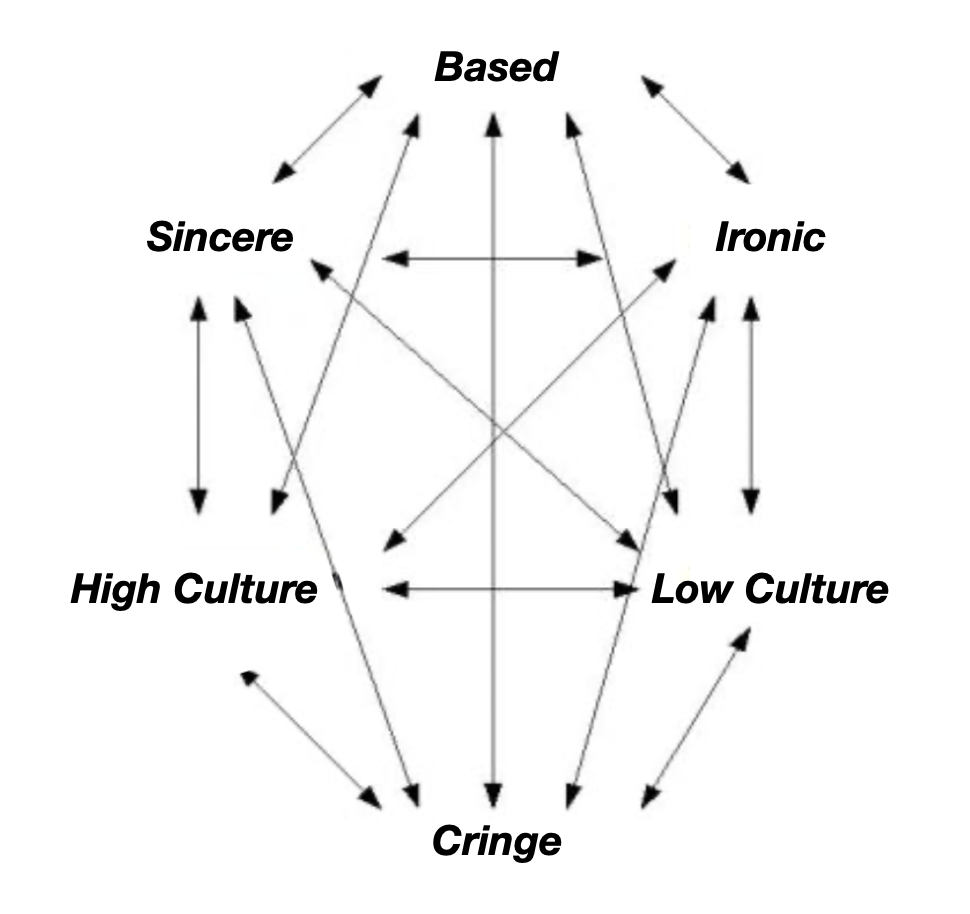
Figure 1
It is only through a conscious recognition of the failures of previous modes of sincerity in art and culture that these same cultural artifacts may be redeemed.
Take for instance the music of the English artist Evian Christ. It may be characterized broadly as a reinterpretation and deconstruction of the aesthetics of ‘90’s Trance music, but one that is stripped of all superfluity. Key for Christ is the “breakdown,” a portion of the standard Trance arrangement in which percussion disappears, and all that remains is the overpowering swell of emotive synthesizers.
Writing in “Rave Culture and Religion”, Hillegonda C. Rietveld describes the breakdown/buildup section of Trance arrangements thus:
“Breaks from the bass-drum pulse are programmed, as a rest from the physical exhaustion, where dancers can ritually predict a build-up of suspense, and where a succession of chords elevates the spirit and the arms, while a euphoric catharsis is produced … when the pulse of the 4/4 bass kick drum, the mechanical heart, returns, literally producing a ‘kick’, an adrenaline rush. The effect is comparable to a roller- coaster ride, where the car is pulled to its highest point, people bursting with suspense, higher, higher...and then let loose to the forces of gravity with thundering abandon.”(Footnote 7)
In Christ’s work, this aspect of Trance is magnified and extrapolated to its logical conclusion. What we have in this music is an intense distillation of emotion, that redeems what many consider in hindsight to be an overindulgent genre characterized by the ridiculous posturing of European DJs with spiked hair. Unlike the works described by Rietveld above, Christ’s music, as one extended breakdown/buildup, never produces the catharsis occasioned by the return of the kick drum’s four-on-the-floor pattern. Rather, it ratchets up the suspense to a point of near sublimation or apotheosis. This aesthetic experience is illustrated by the album artwork for his latest release, Ultra. A photograph of a cresting wave suggests the sublimatory effect of Christ’s work. The swell transmutes liquid ocean into a vaporous mist, evoking the euphoria produced by the “aesthetic” experience of the music, in the sense of philosopher Jacques Rancière’s usage of the term. (Footnote 8)
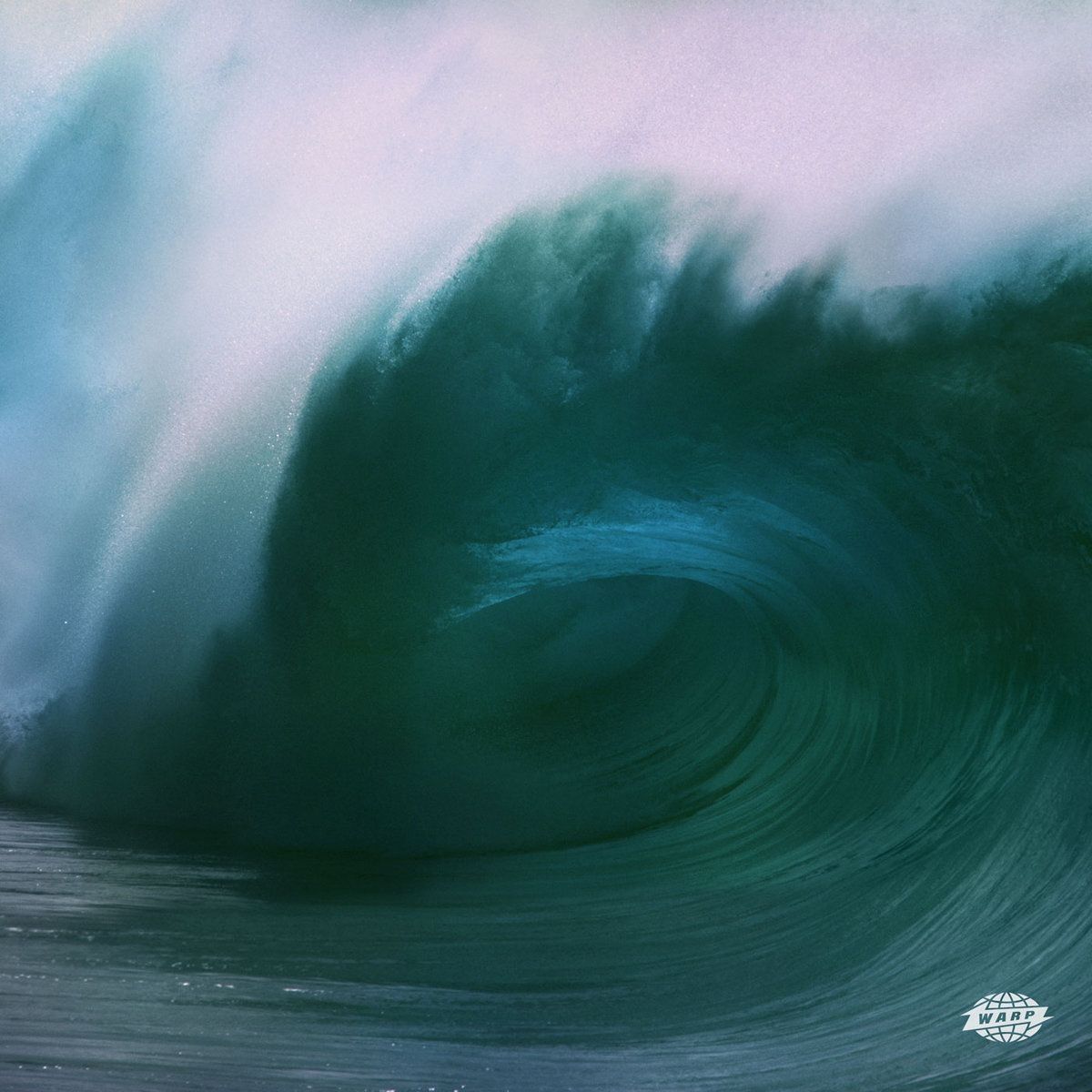
Figure 2: Album artwork for Ultra, by Evian Christ
Christ’s artistic intentions may be further elucidated through consideration of his moniker. It combines a luxury bottled water brand with the title given to Jesus of Nazareth to designate his “anointed” status. This juxtaposition of extreme high and extreme low, of disposable commodity and eternal savior is surely intended somewhat ironically. This ironic awareness and distancing is also to be found in his music.
Ultra crystallizes the ideas detailed above. As the name of the track implies, the piece moves beyond the established aesthetic limits that define much of electronic music today. Rather than pare down his sound to focus on the rhythm and feel of a track, as in the genre of minimal Techno, Christ opts for a deconstructionist approach that is also maximal. Rather than rejecting emotion for a sterile embrace of “cool”, of the groove, Christ leans into the emotionality that marks much of Trance as ingenuous and escapist. Evian Christ has collaborated in the past with the graphic designer David Rudnick, whose inclinations towards beauty and aesthetic experience, elaborated perhaps most eloquently in his baroque typefaces, also celebrate a Romantic maximalism and penchant for emotion. (Footnote 9)
This music recognizes what is “cringe” about Trance, and having recognized this, accelerates this tendency to a point of extremity. In this way, by acknowledging and embracing Cringe, there arises the possibility of Becoming Based. To frame this in a Hegelian sense, we may understand Christ’s music as an aufhebung of cringe, a “sublation,” “transcendence,” or “redemption” that preserves the sincere aspirations of the music while simultaneously shedding the viridity and lack of self-awareness that characterizes much of the genre. (Footnote 10)
“LATELY ARTWORKS HAVE BEGUN TO LOOK MORE LIKE MEMES, WHILE MEMES HAVE BEGUN TO LOOK MORE LIKE ARTWORKS. THE MEMES LOOK NICER, AND OFFER MORE HOPE.”
(Footnote 11)
Moving from the sphere of music to visual art, our discussion brings us to the work of the artist Nick Vyssotsky, specifically a piece entitled La La La La (Inside An Empty Room My Inspiration Flows), an excerpt from his larger installation, Display of Commodity Accessories (Zack’s Room), pictured below. Perhaps one of the most relevant artistic works of this year, the piece highlights the flattening effect of the internet that blurs the boundaries between irony and sincerity, and between high and low cultural forms.

Figure 3: Nick Vyssotsky, Display Of Commodity Accessories (Zack’s Room), 2021
The title of the piece refers both to the video’s soundtrack, a pitch shifted, accelerated “Nightcore” remix of the Y2K-era Eurodance anthem “Around the World (La La La La La)” as well as the larger installation, a waste-filled bedroom seemingly devoid of any worthwhile life. The visual component of the work consists of a series of images that occur in such quick succession, roughly seven per second, so as to function almost subliminally. The deluge of visual referents overwhelms our ability to process them, thereby recreating the experience of the internet today in a hyper-distilled and accelerated fashion. Describing the work on his Instagram page, the artist writes:
“Treating images liked on social media platforms as an archive developed unconsciously. Set in time with the rapid beat of the nightcore remix of the ATC song ‘Around The World’ it feels a bit like an indoctrination video that would be used by MKultra or in the Ludovico Treatment, portraying a vision of the world defined by conflict, technology and absurdity.” (Footnote 12)
The incredibly wide range of subject matter presented by the 1000+ frames also gestures towards the gargantuan scope of the work. Images range from wojak memes to hentai to gore to images of 9/11 and other forms of internet detritus, yet also to the works of the Romantic and the Symbolist schools of painting of the 19th century, with the notable inclusions of both Arnold Böcklin’s The Isle of the Dead and Gustave Moreau’s The Apparition. (Footnote 13)
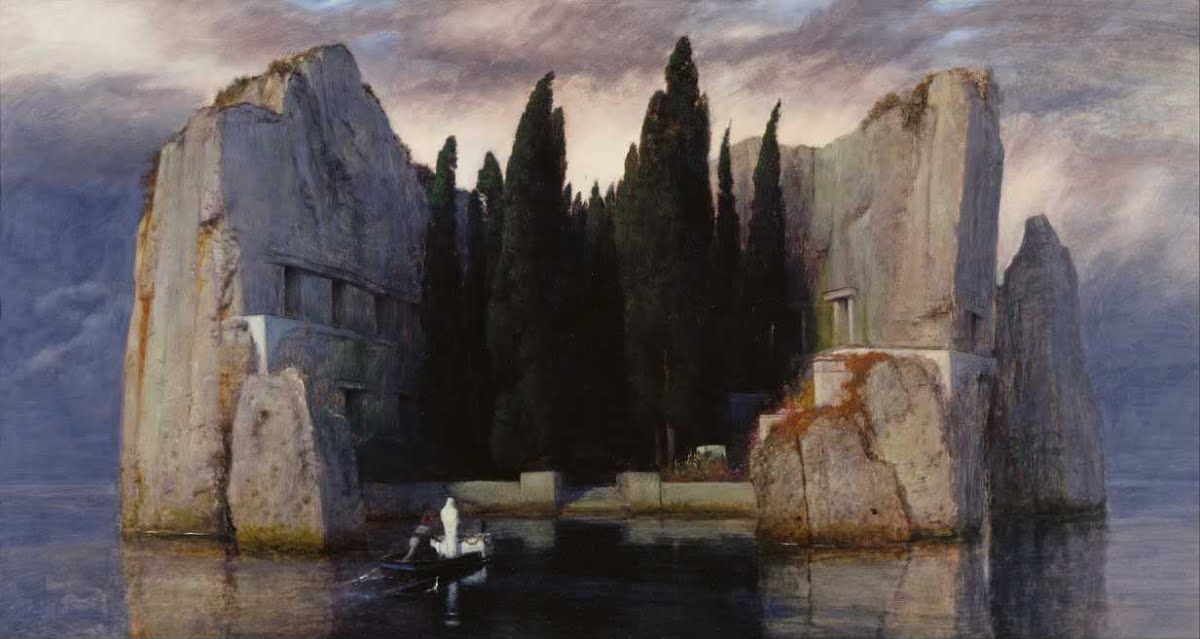
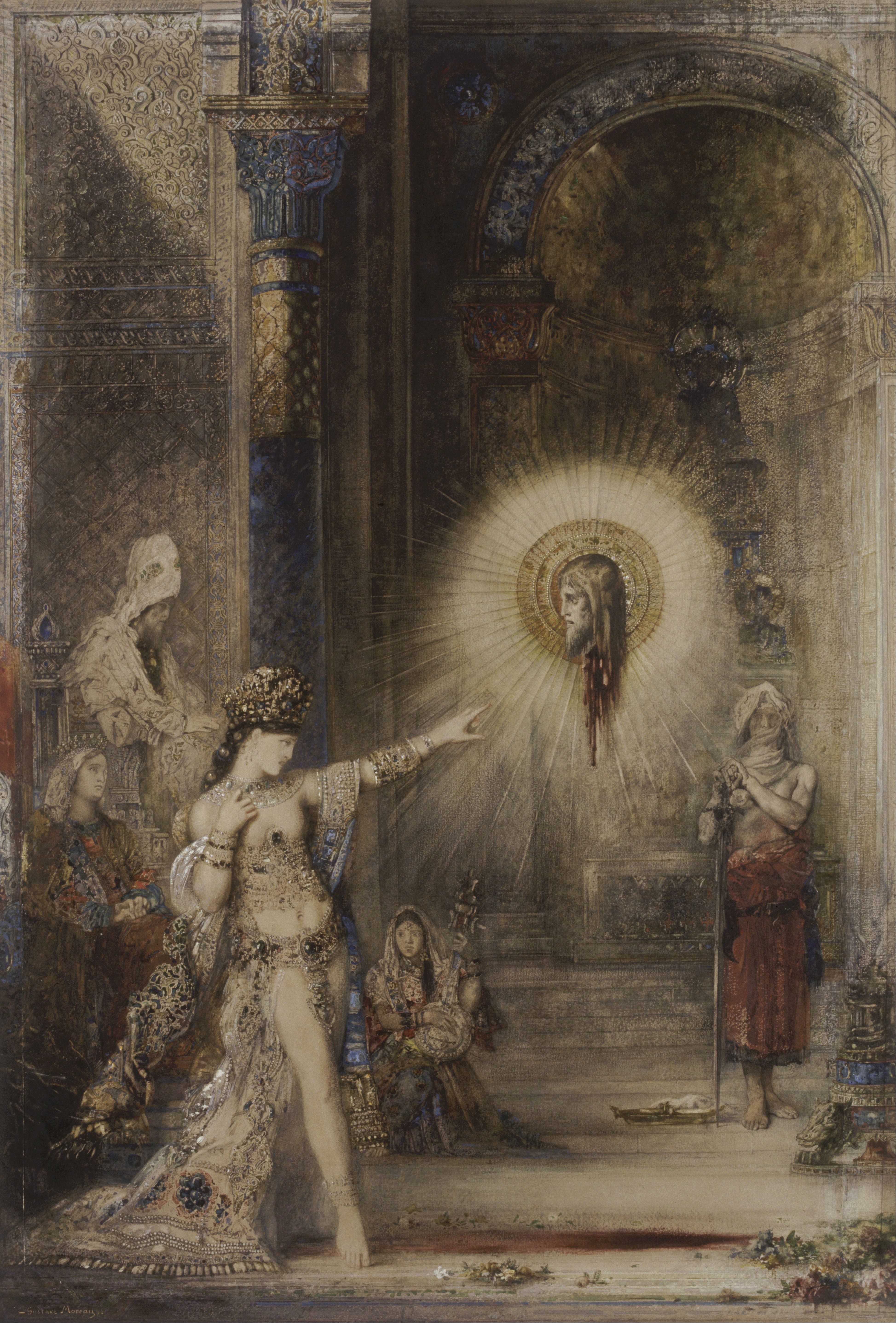
Figure 4: Arnold Böcklin, Isle of the Dead: Third Version, 1883
Figure 5: Gustave Moreau, The Apparition, 1876.
Painted landscapes dotted with Roman ruins run up against digital photos of decrepit bedrooms; a theme of net-era decadence runs through the work. (Footnote 14) While in some sense the piece strips the individual images contained within it of all original context, the ability of the viewer to pause, screenshot, and reverse image search anything she sees challenges this supposed lack of context. In its hyperreferentiality, the work gestures beyond itself, encouraging the viewer to dive into immense rabbit holes of research. (Footnote 15) To make use of an alchemical metaphor, La la la la presents the viewer with a hyper-compressed form of the prima materia, the images of internet abjection and sublime artistic beauty, that informs the rest of Display of Commodity Accessories (Zack’s Room). (Footnote 16)
Viewing Vyssotsky’s piece, you feel a sensation of vertiginous acceleration as the countless stills pummel the visual cortex. This, in conjunction with the sped-up audio, sends you tumbling headlong into the abyss, producing a feeling of near total abandonment to the void. This may be understood as equivalent to the aesthetic category of the sublime, as formulated by philosophers Immanuel Kant and Edmund Burke. (Footnote 17)
Some images bring the postmodern notion of the collapse of the distinction between high and low culture to its logical conclusion, combining memes and high art in a single frame. Take for example the meme protagonist Pepe the Frog inserted into Caspar David Friedrich’s The Wanderer Above the Mist. (Footnote 18) While no individual image can be attributed to the artist, this Pepe Above the Mist seems to crystallize the themes present throughout the work. (Footnote 19)
What is the effect of this violent admixture of high and low culture? Is the work of Friedrich, a German Romantic painter whose oeuvre deals with nature, the self, and the sublime, sullied by the interpolation of Pepe? Or, with his insertion into this famous work, is our tiny green meme protagonist elevated to the realm of high culture? It would be foolish at this point to assert the validity of one or the other of these claims. The consequences of this internet-era phenomenon of temporal and categorical flattening have yet to fully play themselves out. It may yet take decades until the history of this period’s visual culture is able to be written.
Another key assertion of Vyssotsky’s piece is its scope. As implied by the pitch-shifted vocals, constantly echoing the refrain: “It’s all around the world,” the piece would seem to have a global purview. However, it is clear from the nature of the images that this is a world filtered through the processes of the internet. In one’s daily life, in IRL space, things move much more slowly. For many affluent western viewers, the sort of violent and abject images presented in the piece only ever exist online. And yet, there is a truth about the world of today contained in this piece that is not accessible in our everyday lives.
For the first time in history, the average person has immediate access to all the horrors, all the fears, and all the moments of beauty happening today and throughout the past, all over the world. This terrifying assemblage is an infinitely more complex picture of the world than any conceived prior to the diffusion of internet access. Our relationship with this assemblage is made increasingly relevant by the day, as we spend more and more time online, subjected to ever-increasing, ever-accelerating processes of cultural exchange.
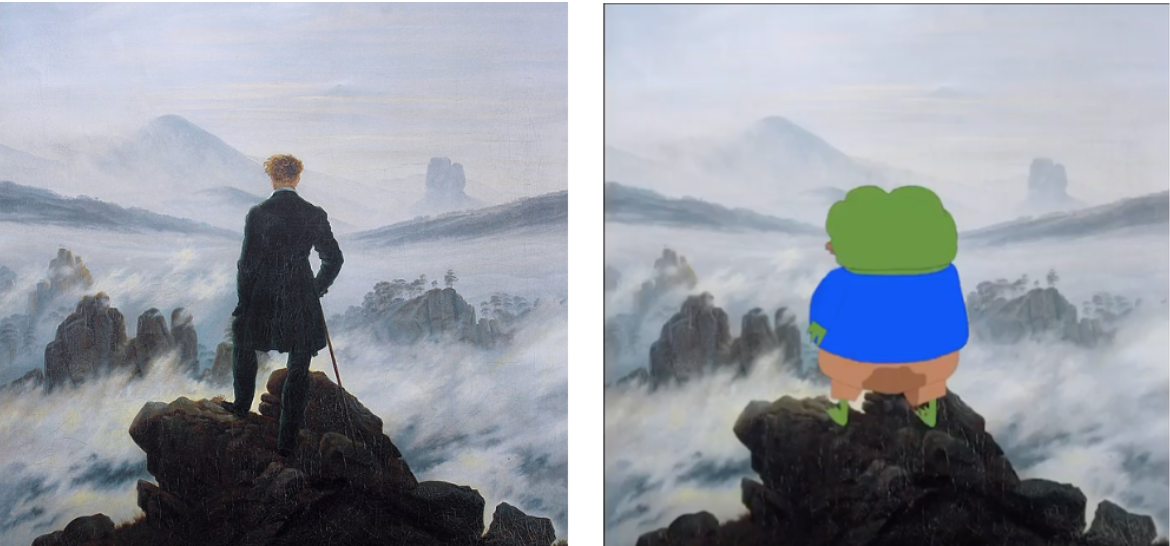
Figure 6: Caspar David Friedrich, The Wanderer Above the Mist, c. 1818
Figure 7: Artist Unknown, Pepe Above the Mist, 201?
In order to further investigate and interpret the piece, it will serve to discuss in brief detail some of the themes present in the work of the Romantic painter Caspar David Friedrich. His works appear five times in La la la la, the most work by any one artist included in the piece. While this represents only a small fraction of the images included, it is nevertheless significant given the thematic content of Friedrich’s work.
The Romantic movement in the arts, while too multifaceted to treat here in any great detail, nevertheless may be broadly characterized by a preference for emotionally powerful aesthetic experience over rational beauty. This desire for a transcendence of the limitations imposed by enlightenment rationality is exemplified by the fascination with the sublime that took hold in this period, most famously elaborated by Edmund Burke in his work on the subject. (Footnote 20)
A large driver for this rejection of pure rationality was the French Revolution and its consequences. With this came the birth of the Modern Age, and a fundamental shock to the identity of Europe. (Footnote 21) Given the fact that supposedly “rational” ideals had led to the horrors of the Reign of Terror, disenchantment with these was bound to follow. In addition to the penchant for emotionality and transcendent aesthetic experience, much of Romanticism also dreamt of a return to a golden age now destroyed by the ravages of Revolution. It was in this milieu that the reactionary mindset (R E T V R N), now so easily observed in online right-wing spaces, was born. However, this movement is not easily reducible along political lines.
Friedrich (1774-1840), heavily influenced by contemporary currents in the arts and sciences, was primarily a landscape painter who highlighted via anthropomorphism the identity of the self with the landscapes that he painted. As Art Historian Nina Amstutz writes in her monograph on the painter:
“Although the Romantics understood human beings as the most evolved and complex life forms, anthropomorphism was far from an empty projection of the self onto inanimate nature. It was rather a means of communing with nature, an effort to understand the self as part of something bigger.” (Footnote 22)
The rückenfiguren (Footnote 23) that populate works like The Wanderer Above the Mist, serve as stand-ins for the viewer, allowing her to enter the space of the painting. This nameless figure, encountering the sublime in the vast expanse that lies before him, asserts “Tat tvam asi.” (Footnote 24) He understands the fundamental unity of himself and all of creation. Vyssotsky’s piece, then, encourages the viewer to look upon this great madness, this unheimlich amalgamation of internet debris and century-old works of art, and recognize its fundamental connection to humanity. In this way, we are all the Pepe Above the Mist.
This recognition of identity further underlines the importance of moving beyond based and cringe. To recognize the self in the other, to recognize the interdependent nature of all humanity, of all existence, is to transcend beyond the need to appear cool or ironically detached. It is Love. A love that does not worry about appearing overly sincere. It is a radical form of sincerity/“Cringe” that does not come from half-understanding Infinite Jest, but from a visceral understanding of our shared humanity.
In viewing La la la la , one comes into intimate contact with the heights and depths of human cultural output. The flattening effect of extreme juxtaposition pushes us to contemplate the throughline, that which connects all of the images flashing before our eyes. While a complete investigation of the visual component of this piece is beyond the scope of our current discussion, the aspects discussed above illustrate how Vyssotsky’s work demonstrates the conditions that make possible today the transcendence of the dichotomy of irony and sincerity. This aufhebung brings us into a radical mode that moves rhizomatically between these two poles, at the same time as it acknowledges their relative character. Based is in the Eye of the Beholder. Intention is less important than the play of symbolic referents, and their branching interconnectivities that affirm how flimsy the appellation of “based” or “cringe” really is. While Vyssotsky’s piece appears at first simply to represent a koyaanisqatsi, a world out of balance, through a recognition of the identity of ourselves and this world, we move to a space of radical empathy and love.
The sincere mode of aesthetic appreciation and reflection advocated by Friedrich and the Romantics is no longer tenable. In this climate of hyperreferentiality, of a blurred distinction between irony and sincerity, the insertion of Pepe is necessary to redeem the sincere aims of these 19th century artists. His presence in this image makes possible the aufhebung of the uncritical sincerity of centuries past. Paradoxically, historical context is simultaneously erased and reinstated by an internet that elides difference as readily as it provides the tools for historical contextualization. Through this synthesis of old and new, sincere and ironic, cringe and based, we move beyond the need for these dichotomies. In this space, we are free to assert our own goals, to assert a new idealistic vision of the future.
BRAD’S CALL TO ACTION
To conclude this investigation of an aesthetic that we may, for lack of a better term, refer to as “Post-Cringe,” we turn to the work of the artist and critic Brad Troemel. In the past year, Troemel has garnered mainstream attention for his reality-bending meme-making practice. With the highly-circulated fake Joe Biden campaign meme, (Footnote 25) Troemel drew attention to the instability and highly contingent nature of the “reality” that is produced via our experiences online. His continuing social-media project, @maincharactersandevents on Instagram, amounts to an ARG, involving the production of endless fake screenshots, documenting “fake news” narratives that challenge the media consensus of Biden’s America (Hunter Biden’s pizzagate paintings, Pete Buttigieg’s “dirtbag centrist” podcast, KAWS’ Backing the Blue™(Footnote 26) and subsequent death, the list goes on).

Figure 8: Brad Troemel’s Instagram profile picture
Yet this impishness, this negative tendency in his work (in the sense of negating a highly-constructed picture of the world), is balanced by the positivity and sincerity of his critical practice. While the practice of critique may be regarded by some as inherently negative, his writing espouses a clear position as much as it critiques current practices. One piece of Troemel’s writing that is particularly relevant to the present discussion is a 2011 essay, entitled Why No Serious?: A Case for Idealism in an Era of Constant Irony. (Footnote 27) Though a decade old, it thoughtfully articulates the contemporary need for idealism in art, and goes a long way towards clarifying the intentions behind Troemel’s work.
After a lucid elaboration of the rise of contemporary irony, from 19th century flaneurship to the total ironic detachment of late ‘00s PBR drinking Urban Outfitters shoppers and 4chan’s shitposting army, Troemel finishes the piece with an exhortation to a new mode of sincerity in art. Drawing on the work of both Søren Kierkegaard and Bruno Latour, he writes:
“Perhaps constant irony is the tail end of Post Modernism’s relentless deconstruction of all things Modern and prior. In the dust of deconstruction there must be some room made for reasoned faith, convictions beyond the non-stop intellectual negations of Post Modernism and the blind spiritual loyalty of Modernism. Soren Kierkegaard frequently wrote about faith, and believed there to be no other way to gain practical wisdom than to step forward and take risks that would lead to experiencing both success and failure. What if more were willing to believe in something so monumental as progress beyond deconstruction — to enter a world of belief, as Bruno Latour describes, “that retain[s] Modernism’s feeling of clarity and order, but freed from its ancient connection to hierarchy and verticality”? In a creative environment that prizes articulated ideals instead of the ability to evade criticism, even failure is an honor for those who were willing to have tried to nudge us closer to their utopia.”
Here Troemel clearly elaborates the need to transcend the ultimate relativism of the postmodern and to advance a sincere vision of the future. Drawing on Kierkegaard, he urges us to take the proverbial Leap of Faith. In our attempts at charting a way forward, we may post cringe. And yet, secure in our beliefs, we can understand our failures as an opportunity to refine our art, existing in a mode of Post-cringe. This piece may not identify the precise form or aesthetics that a new idealistic art would employ, nevertheless it articulates precisely the call that is answered by the works of Evian Christ, Nick Vyssotsky and others. Troemel’s appreciation of Vyssotsky’s output in particular is confirmed by the former’s most recent piece of criticism, The NFT Report. As a coda to this video essay, Troemel includes a sequence of images whose content and arrangement is a direct reference to Vyssotsky’s piece, La la la la. Indeed, he credits Vyssotsky with the concept in this Instagram post. While the precise thematic content of the images in Troemel’s sequence differs slightly from Vyssotsky’s, the aesthetic effect is much the same as that of La la la la, described above.
Additionally, Why No Serious? clarifies the initial opacity of Troemel’s most recent work. In the case of @maincharactersandevents, one must engage in a fair amount of investigation before the question of a given post’s irony or sincerity becomes clear. While perhaps off-putting and confusing to some, the analysis that these posts occasion leads the viewer to reflect on her own situation. They frequently make ironic use of the “cringe,” naïvely sincere, Corporate Memphis aesthetics of the “instagraphic,” to create a momentary rupture. This rupture, causing the viewer to interrogate her circumstances, completes the movement beyond based and cringe. Sincerity is here made tenable by expert use of context. Irony is employed not as an end in its own right, but as a means to advance a sincere goal of breaking the stranglehold of Capitalist Realism.
Once you understand the dark truth, that what is based and what is cringe is purely a matter of perspective, one is freed from the shackles of this juvenile dichotomy. When you realize that the self-aware wink of ironic distance does not preclude your sincere aims, you may become empowered. In a moment of stagnation on the part of the political left, the aesthetic mode outlined above provides the tools to create spaces, however momentary, of rupture. It is in these spaces that we might pause to consider the constructed nature of the world, and that, as constructed, so might it be made anew.
Let us stand on the mountain top, recognize our identity with all that we see, and understand that the self exists in the other, however “cringe” this might sound. Perhaps the sublime beauty of this realization causes us to pee our pants, just a little bit. No matter. We stand undeterred, repeating the mantra: (Footnote 28)
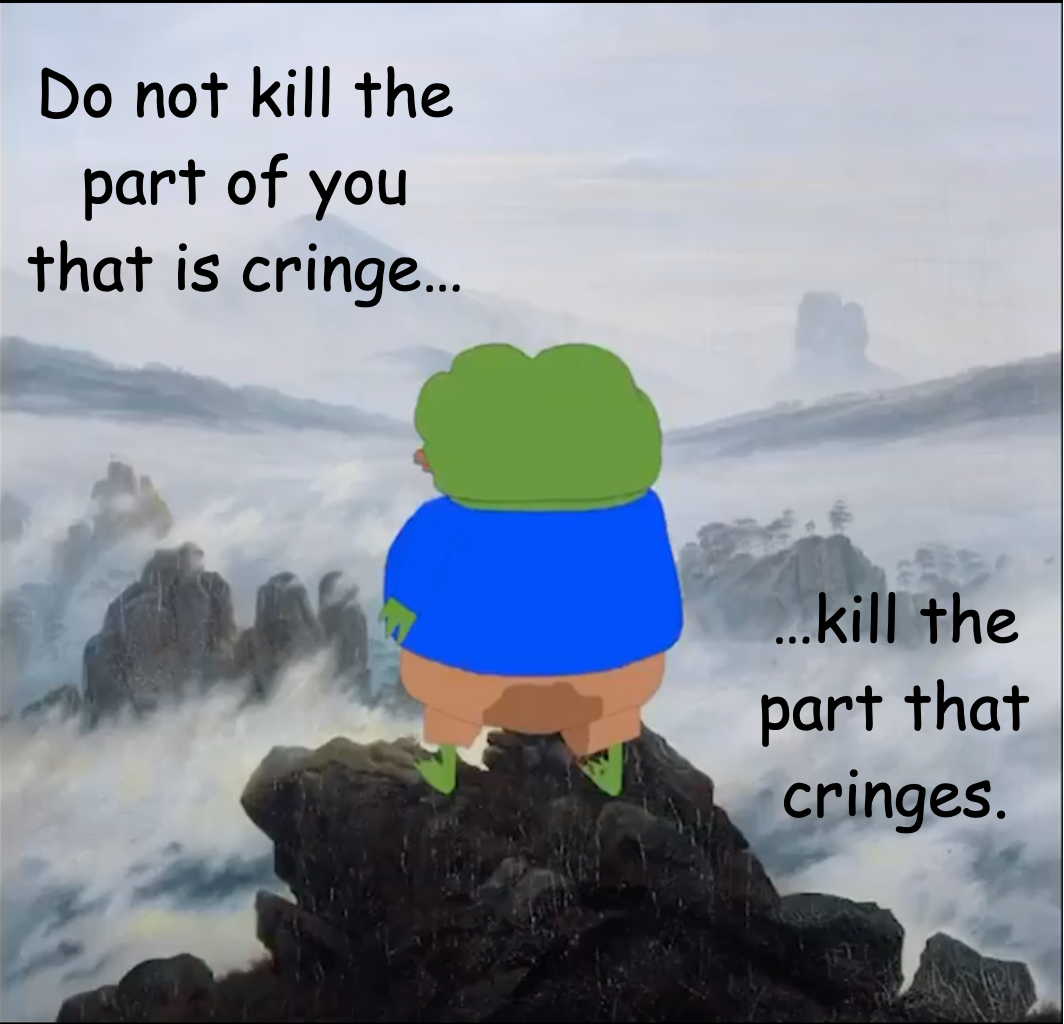
Figure 9
_____________________________________
Footnotes
1. For a deeper examination of the state of online irony in the ‘00s, see: Brad Troemel, “Why No Serious?: A Case for Idealism in an Era of Constant Irony,” in Peer Pressure, 2011. pp. 25-31.
2. The irony of the x-er’s and the american-apparel-era hipsters may have had its part to play in the formation of these reactionary posting environments. Cf. Gavin McInnes’ trajectory from Vice magazine editor to Proud Boys cofounder.
3. For a summary of the New Sincerity as it developed in late 20th c. literature, see: Adam Kelly, “The New Sincerity,” in “Postmodern/Postwar and After: Rethinking American Literature,” 2016.
4. For more on television producer Michael Schur (who has worked on The Office (US), Parks and Recreation, and The Good Place) and his embrace of D. F. Wallace’s sincerity, see: David Itzkoff, “‘Infinite Jest’ Scene, Reborn as a Rock Video.” New York Times. August 22, 2011.
5. Barbara and John Ehrenreich, “The New Left and the Professional-Managerial Class,” in Radical America 11, no. 3 (1977): 7-24.
6. Andrew Marantz, “The Dumb Brilliance of Lil B.” The New Yorker, April 13, 2012.
7. Hillegonda C. Rietveld, “Ephemeral Spirit: Sacrificial Cyborg and Communal Soul.” In Rave Culture and Religion, edited by Graham St John, Routledge 2004. p. 51.
8. Jacques Rancière, ‘The Aesthetic Revolution and its Outcomes: Emplotments of Autonomy and Heteronomy’, New Left Review, March–April 2002, p. 137, and The Politics of Aesthetics, London: Continuum, 2004.
9. Rudnick’s typefaces may be found on his website.
10. Other noteworthy musicians employing a similar mode of referential deconstruction include Death Grips, 100 Gecs, Dorian Electra, and many others the author neglected to include, as well as the label and club night CLUB CRINGE.
11. Dean Kissick, “The Downward Spiral: Popular Things.” Spike Art Magazine, March 10, 2021.
12. Nick Vyssotsky, Instagram post on March 5, 2021.
13. There exists a clear penchant for Romanticism and Symbolism in this piece. Caspar David Friedrich’s work appears at 0:05, 0:29, 0:37, 0:54, 2:14. William Blake’s work appears at 1:00. Goya at 1:43 and 2:22. Arnold Böcklin at 1:01. Gustave Moreau at 0:55, 1:21, 1:36. Gustave Doré 1:55. While the Symbolist movement came about two generations after Romanticism, Symbolist painting in particular emphasized some of the mystical qualities first explored in Romanticism. Other Art Historical periods are referred to as well, including Buddhist mandalas at 0:25, 1:19, 1:46, Medieval manuscript illustration at 2:03 and 2:24, Fra Angelico’s last judgment at 2:06, and probably other examples this author has missed. Nevertheless, the Romantic and Symbolist schools seem to be the most represented in the “high art” that is contained in the piece.
14. Vyssotsky’s predilection towards images of decadence and decay also locates his work within the bounds of an aesthetic trend identified by cultural critics Caroline Busta and Julian Wadsworth as “The New Gothic.” Busta, Caroline, Julian Wadsworth, Towards a New Gothic, Kaleidoscope, FW 2019. Vyssotsky also situates himself within the movement of Post-Internet Art, which takes as its starting point the modern condition of a society whose most intimate processes are shaped by the digital realm.
15. [DO NOT RESEARCH].
16. Nick Vyssotsky, Battlestations, 2021.
17. See: Edmund Burke, A Philosophical Enquiry Into the Origin of Our Ideas of the Sublime and Beautiful, 1757, and Immanuel Kant, Observations on the Feeling of the Beautiful and Sublime, 1764.
18. Technically, this is a variation of Pepe identified as Peepo or Apu Apustaja. Pepe Above the Mist appears at 0:54. Another example of this high/low combination, an anime-style version of Francisco Goya’s Saturn Devouring His Son, appears at 2:22.
19. his instantiation of high culture within the bounds of the crass, the mundane, may also be observed in other areas of Vyssotsky’s work. Consider das Schloss und die goldenen Kugeln, which places a 3D-printed scale replica of Neuschwanstein Castle inside an economy-sized tub of cheese doodles. A Romantic simulacrum of the past is contained within the bounds of a consumeristic umwelt that forecloses all such dreams of grandeur. Further complicating contemporary nostalgia for a past supposedly represented by Neuschwanstein is the fact that the castle itself, built 1869-84, was a historicizing attempt to instantiate a vision of a Medieval past that was a fictional projection of the castle’s builders. For more on the reactionary motivations behind revival architecture in the 19th c., see Sloan 2019.
20. See note 17.
21. For more on the post-Revolution birth of the reactionary mindset, see Frank Ankersmit, “The Sublime Dissociation of the Past: Or How to Be(Come) What One Is No Longer.” History and Theory 40, no. 3 (October 2001): 295–323.
22. Nina Amstutz, Caspar David Friedrich: Nature and the Self. New Haven: Yale University Press, 2020. p. 219.
23. German for “figures painted from behind.”
24. “Tat tvam asi,” (Sanskrit: “thou art that”) in Hinduism, the famous expression of the relationship between the individual and the Absolute.” Encyclopedia Britannica, Tat Tvam Asi; “My true inner essence exists in every living thing as immediately as it reveals itself in my self-consciousness to myself alone. – It is this knowledge, for which the standing expression in Sanskrit is the formula tat-twam asi, i.e. ‘You are that’ [...].” Arthur Schopenhauer, The Two Fundamental Problems of Ethics, pp. 253-54.
25. Alex Greenberger, Artist Brad Troemel Claims Responsibility for Creating Viral Fake Joe Biden Ad, Artnews, April 27, 2020.
26. RIP KAWS
27. Brad Troemel, “Why No Serious?: A Case for Idealism in an Era of Constant Irony,” in Peer Pressure, 2011. p. 31.
28. It must be noted here that this discussion, limited in its length and scope as it is, can in no way do justice to all the artists today who are employing these aesthetic principles to great effect. The author’s lived experience and biases surely also play their part in creating blind spots of analysis. Therefore, please consider this essay to be a jumping off point, and an opportunity for creative discourse.